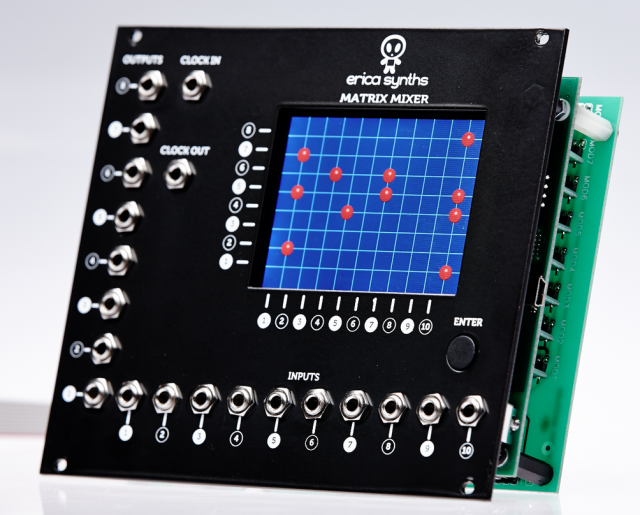
Erica Synths has released the Matrix Mixer – a new touchscreen matrix mixer, inspired by the EMS Synthi.
Here’s what they have to say about the Matrix Mixer:
It allows you to route any (or several simultaneously) of 10 inputs to any (or several simultaneously) of 8 outputs. Input signals (audio and/or control voltage) are not only connected mechanically; they are mixed together on a buffered input mixer. Likewise, if you wish to route one input to several outputs (use the Matrix Mixer as a splitter), outputs will be buffered also.
250 patches can be saved in the internal memory and recalled instantly. The module has unique Performance mode, when you can chain multiple patches in a long performance so that patches change automatically, clocked by external or internal clock. Matrix Mixer saves 128 infinitely long Performances.
Here’s the official intro video for the Matrix Mixer:
Technical specs:
- Inputs: 10
- Outputs: 8
- Signal mode: both audio and CV
- Input signal level: up to 20 Vptp
- Mixer gain: 1
- Resistive touchscreen: 3,2”
- Internal clock: 20-320 BPM
- Panel width: 49,5HP
- Module Depth: 40mm
- Power supply: bipolar +-12V , eurorack standard
- Power consumption: 150mA@+12V, 45mA@-12V
The Matrix Mixer is available now for 450 EUR.

this is so stupid why do u put a cheap touchscreen into a modul when the joy and the best thing in it are patchcables!
you can have a much fancy touchscreen audio softs with ipad
Totally agree with you, I bought my modular the knobs and cables…. NOT THE TOUCHSCREENS…..If I wanted touchscreens I’d buy an ipad…
Could not disagree with your more. This is a natural evolution of modular synths. Are we expected to see these synth makers to simply regurgitate the same 1950’s and 60’s designs?
This and another module I recently came across with a very usable LCD screen actually sparked my interest in modulars for the first time.
the lcd screen is way to small
The screen is small, yes, but even if you have to use a stylus, its just a grid and nothing else, and still cheaper and more flexible than a real pin matrix, and having to use a stylus even if not the most ideal, is still more more ideal at least for me than keeping track of expensive proprietary pins. That being said I still wish they’d make the screen bigger, not a deal breaker though.
You can’t automate patch changes with a mechanical pin matrix, though.
..use the resultant unused patch cable(s) end as a stylus…problem solved and you will still feel like you are patching with a cable 😛
Hey! Touchscreen works fine, it looks unresponsive because Girts is trying to point it from one side so you can see what he is doing!?
We will make another demo soon so you can see that it works just fine!
Our bad. :-/
Heresy!
I like it because it looks like the Megaman 2 password screen.
I really like the module and the concept behind it – the only question I ask myself is: does it really need to take that much rackspace? Wouldn’t it be possible to build it in like 24hp? The front panel at least looks like that should easily be possible… (and if it really needs that size – make the next production run 50hp, not something .5, please!)
It needs that much space ’cause otherwise it’s not possible to route all stuff behind it. 24 switching ICs are even placed on 8 small perpendicular PCBs. Or put it simple – with smaller panel you would point not in the touchscreen, but in bunch of wires 🙂
Fair enough, got it! 🙂
(but still, please consider that odd .5 thing 🙂 )
In June of this or next year? Seems useful but tiny touch screen is more than off putting..
It’s available now via our webshop – http://www.ericasynths.lv
Wish they had labeled the rows with letters instead of numbers. Somehow A-6 is just more meaningful to me than 1-6. But that’s a very minor nit. Great idea!